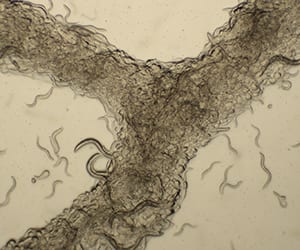News
Worms Communicate Using a Complex Chemical Language
 Scientists have discovered that a species of small, transparent roundworms called Caenorhabditis elegans possess a highly-evolved language in which they combine chemical fragments to create precise molecular messages that control social behavior. The research was conducted at the Boyce Thompson Institute (BTI) at Cornell University and the California Institute of Technology (Caltech) and published in the January issue of PLoS Biology.
Scientists have discovered that a species of small, transparent roundworms called Caenorhabditis elegans possess a highly-evolved language in which they combine chemical fragments to create precise molecular messages that control social behavior. The research was conducted at the Boyce Thompson Institute (BTI) at Cornell University and the California Institute of Technology (Caltech) and published in the January issue of PLoS Biology.
The research holds promise in helping to develop new treatments for the more than 20 percent of the world’s population infected with nematodes and for agricultural producers whose crops are destroyed by the pests. “Learning about how nematodes communicate opens up new possibilities for prevention of nematode infection in humans and nematode control in agricultural settings,” said Frank Schroeder, faculty at BTI and a corresponding author of the paper. BTI postdoc Stephan von Reuss, one of the two lead authors of the study explained that “using the worm’s own language, we may be able to disrupt their development and reproduction or attract them to lethal environments.”
C. elegans is a lab-friendly model species for research on how chemical signals affect development and behavior. In 2008, Schroeder and colleagues had discovered that nematodes use chemical signals as sexual attractants, which provided the first hint that nematodes use chemistry to talk. “What we understand now is that nematodes use complex messages that consist of molecules put together in a modular fashion,” explained Schroeder. “They put together different chemical fragments depending on what they want to say.”
For example, the researchers found several molecules that tell nematodes to scatter and disperse. These molecules consist of only two building blocks. But adding a third building block called an indole changes the meaning completely: instead of “go away” the message becomes “everybody come here.” Nematode messages get even more complex by combining two or more different molecules, just like combining different words in a sentence makes for more complex meaning.
Schroeder and his team used a new analytical method called comparative metabolomics to analyze the chemicals made by worms. By comparing the body chemistry of normal, wild-type worms with the chemistry of worms that have a signaling defect, i.e. “worms that can’t talk”, the researchers detected molecules that were only present in wild-type worms, but not in “silent” worms. These molecules then turned out to form the “language of the worm”. <
These results show that by combining molecules that include different types of chemical building blocks, worms have developed a sophisticated chemical language that they use to organize their communities. The discovery provides a new window into the chemistry of life and suggests that many other animal species including vertebrates may produce similar signaling molecules to control behavior and other biological functions.
As a next step, the researchers will explore how the worms’ nervous system senses and deciphers the different chemical messages. “Understanding the worm’s language is just a first step – we now need to figure out how the worm decodes and makes these molecules,” Schroeder says.
The study, “A Modular Library of Small Molecule Signals Regulates Social Behaviors in Caenorhabditis elegans,” was funded by the National Institutes of Health and the Howard Hughes Medical Institute. Other members of the Schroeder lab who contributed to the study were graduate students Neelanjan Bose, Parag Mahanti, and Oran G. O’Doherty. Caltech researchers Paul Sternberg, Jagan Srinivasan, Alon Zaslaver, and Margaret Ho, along with Arthur Edison of the University of Gainesville in Florida, were also coauthors on the paper.
The Boyce Thompson Institute is an independent affiliate of Cornell University.
More on the Schroeder Lab
Worms communicate: PLoS Biology 2012 Read Article


